Lamellar Spacing Modelling for LPBF Aluminum Parts
Abstract
:1. Introduction
2. Materials and Methods
2.1. Samples Manufacturing
2.2. Metallographic Characterization
2.3. Modeling
2.3.1. Thermo–Physical Material Properties Calculation
2.3.2. Sample Manufacturing Modeling
2.3.3. Microstructure Prediction
3. Results and Discussion
3.1. Metalographycal Characterization
3.2. Sample Manufacturing Simulation
3.3. Microstructure Modeling
4. Conclusions
Author Contributions
Funding
Data Availability Statement
Conflicts of Interest
References
- Dilberoglu, U.M.; Gharehpapagh, B.; Yaman, U.; Dolen, M. The Role of Additive Manufacturing in the Era of Industry 4.0. Procedia Manuf. 2017, 11, 545–554. [Google Scholar] [CrossRef]
- AMPOWER. AMPOWER REPORT 2022; AMPOWER: Hamburg, Germany, 2022. [Google Scholar]
- Yap, C.Y.; Chua, C.K.; Dong, Z.L.; Liu, Z.H.; Zhang, D.Q.; Loh, L.E.; Sing, S.L. Review of Selective Laser Melting: Materials and Applications. Appl. Phys. Rev. 2015, 2, 041101. [Google Scholar] [CrossRef]
- Michi, R.A.; Plotkowski, A.; Shyam, A.; Dehoff, R.R.; Babu, S.S. Towards High-Temperature Applications of Aluminium Alloys Enabled by Additive Manufacturing. Int. Mater. Rev. 2022, 67, 298–345. [Google Scholar] [CrossRef]
- Jia, Q.; Rometsch, P.; Cao, S.; Zhang, K.; Wu, X. Towards a High Strength Aluminium Alloy Development Methodology for Selective Laser Melting. Mater. Des. 2019, 174, 107775. [Google Scholar] [CrossRef]
- Mertens, A.; Delahaye, J.; Dedry, O.; Vertruyen, B.; Tchuindjang, J.T.; Habraken, A.M. Microstructure and Properties of SLM AlSi10Mg: Understanding the Influence of the Local Thermal History. Procedia Manuf. 2020, 47, 1089–1095. [Google Scholar] [CrossRef]
- Rao, H.; Giet, S.; Yang, K.; Wu, X.; Davies, C.H.J. The Influence of Processing Parameters on Aluminium Alloy A357 Manufactured by Selective Laser Melting. Mater. Des. 2016, 109, 334–346. [Google Scholar] [CrossRef]
- Wang, P.; Li, H.C.; Prashanth, K.G.; Eckert, J.; Scudino, S. Selective Laser Melting of Al-Zn-Mg-Cu: Heat Treatment, Microstructure and Mechanical Properties. J. Alloy. Compd. 2017, 707, 287–290. [Google Scholar] [CrossRef]
- Olakanmi, E.O.; Cochrane, R.F.; Dalgarno, K.W. A Review on Selective Laser Sintering/Melting (SLS/SLM) of Aluminium Alloy Powders: Processing, Microstructure, and Properties. Prog. Mater. Sci. 2015, 74, 401–477. [Google Scholar] [CrossRef]
- Bidare, P.; Bitharas, I.; Ward, R.M.; Attallah, M.M.; Moore, A.J. Fluid and Particle Dynamics in Laser Powder Bed Fusion. Acta Mater. 2018, 142, 107–120. [Google Scholar] [CrossRef]
- Acharya, R.; Sharon, J.A.; Staroselsky, A. Prediction of Microstructure in Laser Powder Bed Fusion Process. Acta Mater. 2017, 124, 360–371. [Google Scholar] [CrossRef]
- Zhang, Z.; Huang, Y.; Kasinathan, A.R.; Shahabad, S.I.; Ali, U.; Mahmoodkhani, Y.; Toyserkani, E. 3-Dimensional Heat Transfer Modeling for Laser Powder-Bed Fusion Additive Manufacturing with Volumetric Heat Sources Based on Varied Thermal Conductivity and Absorptivity. Opt. Laser Technol. 2019, 109, 297–312. [Google Scholar] [CrossRef]
- Denlinger, E.R.; Jagdale, V.; Srinivasan, G.V.; El-Wardany, T.; Michaleris, P. Thermal Modeling of Inconel 718 Processed with Powder Bed Fusion and Experimental Validation Using in Situ Measurements. Addit. Manuf. 2016, 11, 7–15. [Google Scholar] [CrossRef]
- Azizi, H.; Ebrahimi, A.; Ofori-Opoku, N.; Greenwood, M.; Provatas, N.; Mohammadi, M. Characterizing the Microstructural Effect of Build Direction during Solidification of Laser-Powder Bed Fusion of Al-Si Alloys in the Dilute Limit: A Phase-Field Study. Acta Mater. 2021, 214, 116983. [Google Scholar] [CrossRef]
- Rehman, A.U.; Mahmood, M.A.; Ansari, P.; Pitir, F.; Salamci, M.U.; Popescu, A.C.; Mihailescu, I.N. Spatter Formation and Splashing Induced Defects in Laser-Based Powder Bed Fusion of AlSi10Mg Alloy: A Novel Hydrodynamics Modelling with Empirical Testing. Metals 2021, 11, 2023. [Google Scholar] [CrossRef]
- Gokcekaya, O.; Ishimoto, T.; Hibino, S.; Yasutomi, J.; Narushima, T.; Nakano, T. Unique Crystallographic Texture Formation in Inconel 718 by Laser Powder Bed Fusion and Its Effect on Mechanical Anisotropy. Acta Mater. 2021, 212, 116876. [Google Scholar] [CrossRef]
- Zhang, Y.; Jung, Y.G.; Zhang, J. Multiscale Modeling of Additively Manufactured Metals; Elsevier: Amsterdam, The Netherlands, 2020. [Google Scholar]
- Shao, W.; He, B.; Qiu, C.; Li, Z. Effect of Hatch Spacing and Laser Remelting on the Formation of Unique Crystallographic Texture of IN718 Superalloy Fabricated via Laser Powder Bed Fusion. Opt. Laser Technol. 2022, 156, 108609. [Google Scholar] [CrossRef]
- Foteinopoulos, P.; Papacharalampopoulos, A.; Stavropoulos, P. On Thermal Modeling of Additive Manufacturing Processes. CIRP J. Manuf. Sci. Technol. 2018, 20, 66–83. [Google Scholar] [CrossRef]
- Stavropoulos, P.; Foteinopoulos, P. Modelling of Additive Manufacturing Processes: A Review and Classification. Manuf. Rev. 2018, 5, 2. [Google Scholar] [CrossRef] [Green Version]
- Foteinopoulos, P.; Papacharalampopoulos, A.; Angelopoulos, K.; Stavropoulos, P. Development of a Simulation Approach for Laser Powder Bed Fusion Based on Scanning Strategy Selection. Int. J. Adv. Manuf. Technol. 2020, 108, 3085–3100. [Google Scholar] [CrossRef]
- Stavropoulos, P.; Foteinopoulos, P.; Papapacharalampopoulos, A. On the Impact of Additive Manufacturing Processes Complexity on Modelling. Appl. Sci. 2021, 11, 7743. [Google Scholar] [CrossRef]
- Fiedler, T.; Dörries, K.; Rösler, J. Selective Laser Melting of Al and AlSi10Mg: Parameter Study and Creep Experiments. Prog. Addit. Manuf. 2022, 7, 583–592. [Google Scholar] [CrossRef]
- Snopiński, P.; Woźniak, A.; Pagáč, M. Microstructural Evolution, Hardness, and Strengthening Mechanisms in SLM AlSi10Mg Alloy Subjected to Equal-Channel Angular Pressing (ECAP). Materials 2021, 14, 7598. [Google Scholar] [CrossRef] [PubMed]
- Aboulkhair, N.T.; Everitt, N.M.; Ashcroft, I.; Tuck, C. Reducing Porosity in AlSi10Mg Parts Processed by Selective Laser Melting. Addit. Manuf. 2014, 1–4, 77–86. [Google Scholar] [CrossRef]
- Lawson, J. Design and Analysis of Experiments with R; Texts in Statistical Science Series; CRC Press: New York, NY, USA, 2015; ISBN 978-1-4987-2848-5. [Google Scholar]
- ASTM E407-07(2015)E1; Standard Practice for Microetching Metals and Alloys. ASTM: West Conshohocken, PA, USA, 2015.
- Liu, Z.-K. First-Principles Calculations and CALPHAD Modeling of Thermodynamics. J. Phase Equilibria Diffus. 2009, 30, 517–534. [Google Scholar] [CrossRef]
- CompuTherm LLC. CompuTherm; CompuTherm LLC: Middleton, WI, USA.
- Majeed, M.; Khan, H.M.; Rasheed, I. Finite Element Analysis of Melt Pool Thermal Characteristics with Passing Laser in SLM Process. Optik 2019, 194, 163068. [Google Scholar] [CrossRef]
- Larouche, D. Computation of Solidification Paths in Multiphase Alloys with Back-Diffusion. Calphad 2007, 31, 490–504. [Google Scholar] [CrossRef]
- Bennett, L.H.; Carter, G.C. Enhanced Lever Rule for High-Precision Phase Diagram Determination. Met. Mater. Trans. B 1971, 2, 3079–3081. [Google Scholar] [CrossRef]
- Chen, S.-L.; Yang, Y.; Chen, S.-W.; Lu, X.-G.; Chang, Y.A. Solidification Simulation Using Scheil Model in Multicomponent Systems. J. Phase Equilibria Diffus. 2009, 30, 429–434. [Google Scholar] [CrossRef]
- Altair Inspire Print3D. Available online: https://www.altair.com.es/inspire-print3d/ (accessed on 1 December 2022).
- Pedregosa, F.; Varoquaux, G.; Gramfort, A.; Michel, V.; Thirion, B.; Grisel, O.; Blondel, M.; Müller, A.; Nothman, J.; Louppe, G.; et al. Scikit-learn: Machine Learning in Python. J. Mach. Learn. Res. 2011, 12, 2825–2830. [Google Scholar] [CrossRef]
- ESI Group. ProCAST. 2019. Available online: https://www.esi-group.com/products/casting (accessed on 1 December 2022).
- Oldfield, W. Freezing of Cast Irons. ASM Trans. 1966, 59, 945–959. [Google Scholar]
- Anglada, E.; Meléndez, A.; Vicario, I.; Arratibel, E.; Aguillo, I. Adjustment of a High Pressure Die Casting Simulation Model against Experimental Data. Procedia Eng. 2015, 132, 966–973. [Google Scholar] [CrossRef]
- Trinoga, M. Development of an Automated Thermal Model Correlation Tool. In Proceedings of the 28th European Space Thermal Analysis Workshop, Noordwijk, The Netherlands, 14–15 October 2014; pp. 201–212. [Google Scholar]
- Welch, J.W. Thermal Testing. In Spacecraft Thermal Control Handbook; Gilmore, D.G., Ed.; The Aerospace Press: El Segundo, CA, USA, 2002; pp. 713–758. ISBN 1-884989-11-X. [Google Scholar]
- Anglada, E.; Meléndez, A.; Maestro, L.; Dominguez, I. Adjustment of Numerical Simulation Model to the Investment Casting Process. Procedia Eng. 2013, 63, 75–83. [Google Scholar] [CrossRef] [Green Version]
- Anglada, E.; Garmendia, I. Correlation of Thermal Mathematical Models for Thermal Control of Space Vehicles by Means of Genetic Algorithms. Acta Astronaut. 2015, 108, 1–17. [Google Scholar] [CrossRef]
- Anglada, E.; Martinez-Jimenez, L.; Garmendia, I. Performance of Gradient-Based Solutions versus Genetic Algorithms in the Correlation of Thermal Mathematical Models of Spacecrafts. Int. J. Aerosp. Eng. 2017, 2017, 7683457. [Google Scholar] [CrossRef]
- Garmendia, I.; Anglada, E. Thermal Parameters Identification in the Correlation of Spacecraft Thermal Models against Thermal Test Results. Acta Astronaut. 2022, 191, 270–278. [Google Scholar] [CrossRef]
- Anglada, E.; Meléndez, A.; Obregón, A.; Villanueva, E.; Garmendia, I. Performance of Optimization Algorithms in the Model Fitting of the Multi-Scale Numerical Simulation of Ductile Iron Solidification. Metals 2020, 10, 1071. [Google Scholar] [CrossRef]
- Klement, J.; Anglada, E.; Garmendia, I. Advances in Automatic Thermal Model to Test Correlation in Space Industry. In Proceedings of the 46th International Conference on Environmental Systems, Lubbock, TX, USA, 10–14 July 2016; pp. 1–11. [Google Scholar]
- Torralbo, I.; Perez-Grande, I.; Sanz-Andrés, A.; Piqueras, J. Correlation of Thermal Mathematical Models to Test Data Using Jacobian Matrix Formulation. In Proceedings of the 48th International Conference on Environmental Systems iICES-2018, Alburquerque, NM, USA, 8–12 July 2018; Volume ICES-2018-, p. 11. [Google Scholar]
- Beck, T.; Bieler, A.; Thomas, N. Numerical Thermal Mathematical Model Correlation to Thermal Balance Test Using Adaptive Particle Swarm Optimization (APSO). Appl. Eng. 2012, 38, 168–174. [Google Scholar] [CrossRef]
- Biscani, F.; Izzo, D. A parallel global multiobjective framework for optimization: Pagmo. J. Open Source Software. 2020, 5(53), 2338. [Google Scholar] [CrossRef]
- Powell, M.J.D. The NEWUOA Software for Unconstrained Optimization with Derivatives. In Large-Scale Nonlinear Optimization; di Pillo, G., Roma, M., Eds.; Springer: New York, NY, USA, 2006; pp. 255–297. ISBN 978-0387-30063-4. [Google Scholar]
- Jägle, E.A.; Sheng, Z.; Wu, L.; Lu, L.; Risse, J.; Weisheit, A.; Raabe, D. Precipitation Reactions in Age-Hardenable Alloys During Laser Additive Manufacturing. JOM 2016, 68, 943–949. [Google Scholar] [CrossRef] [Green Version]
- Pauly, S.; Wang, P.; Kühn, U.; Kosiba, K. Experimental Determination of Cooling Rates in Selectively Laser-Melted Eutectic Al-33Cu. Addit Manuf. 2018, 22, 753–757. [Google Scholar] [CrossRef]
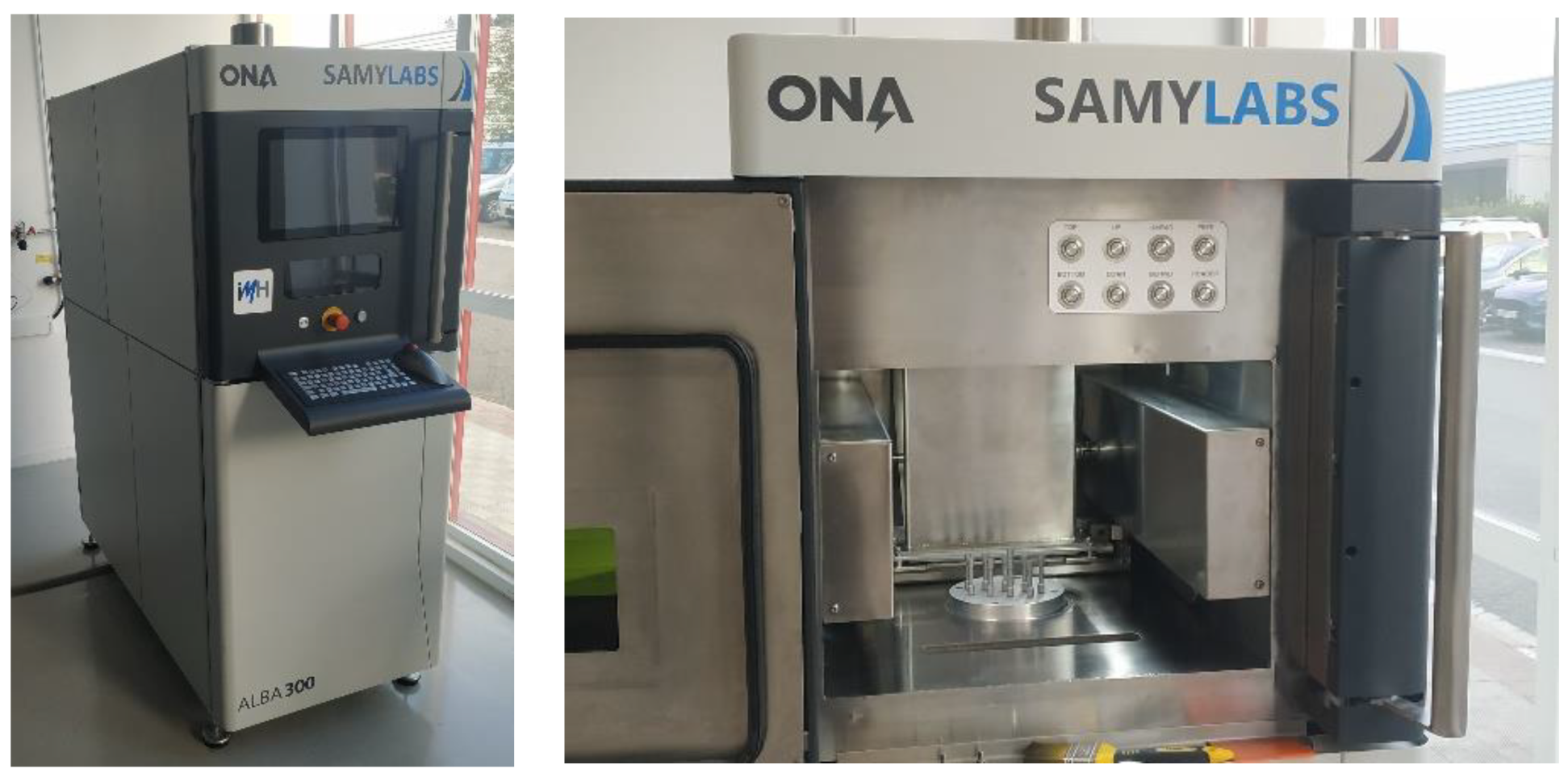

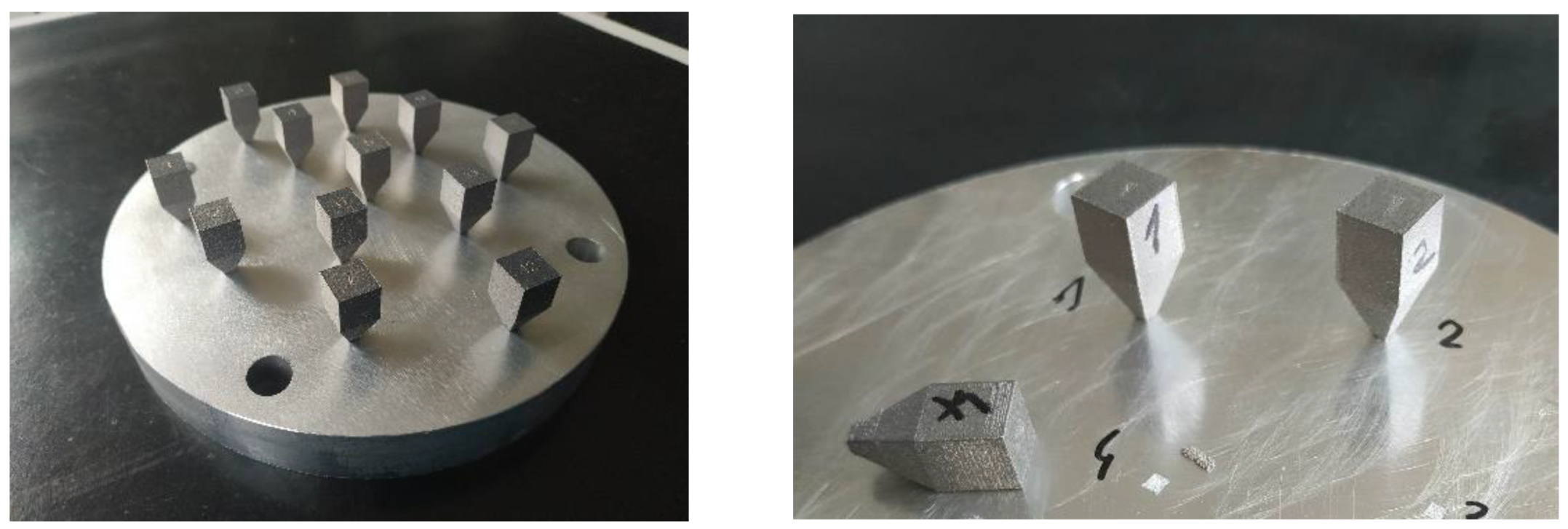
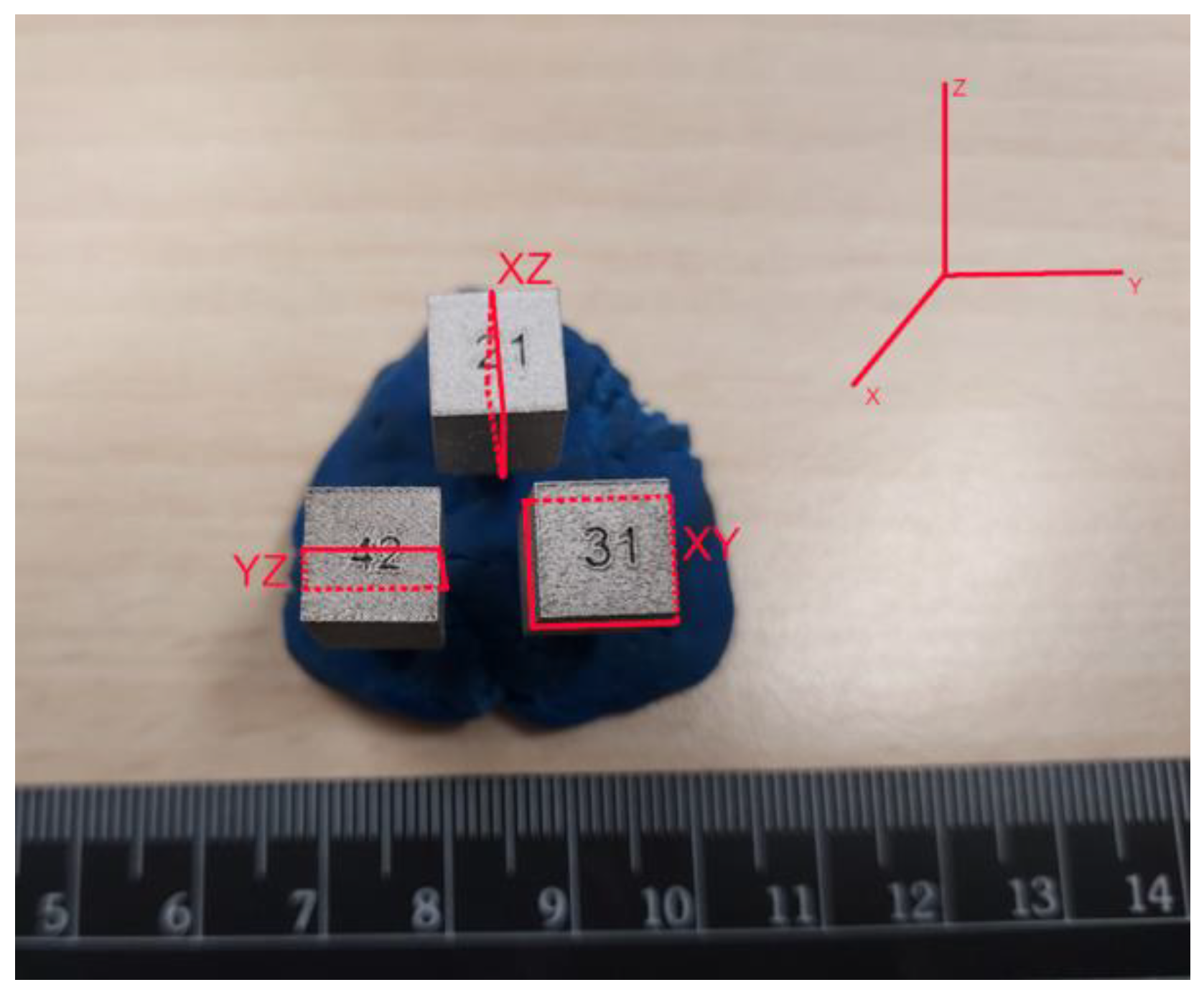

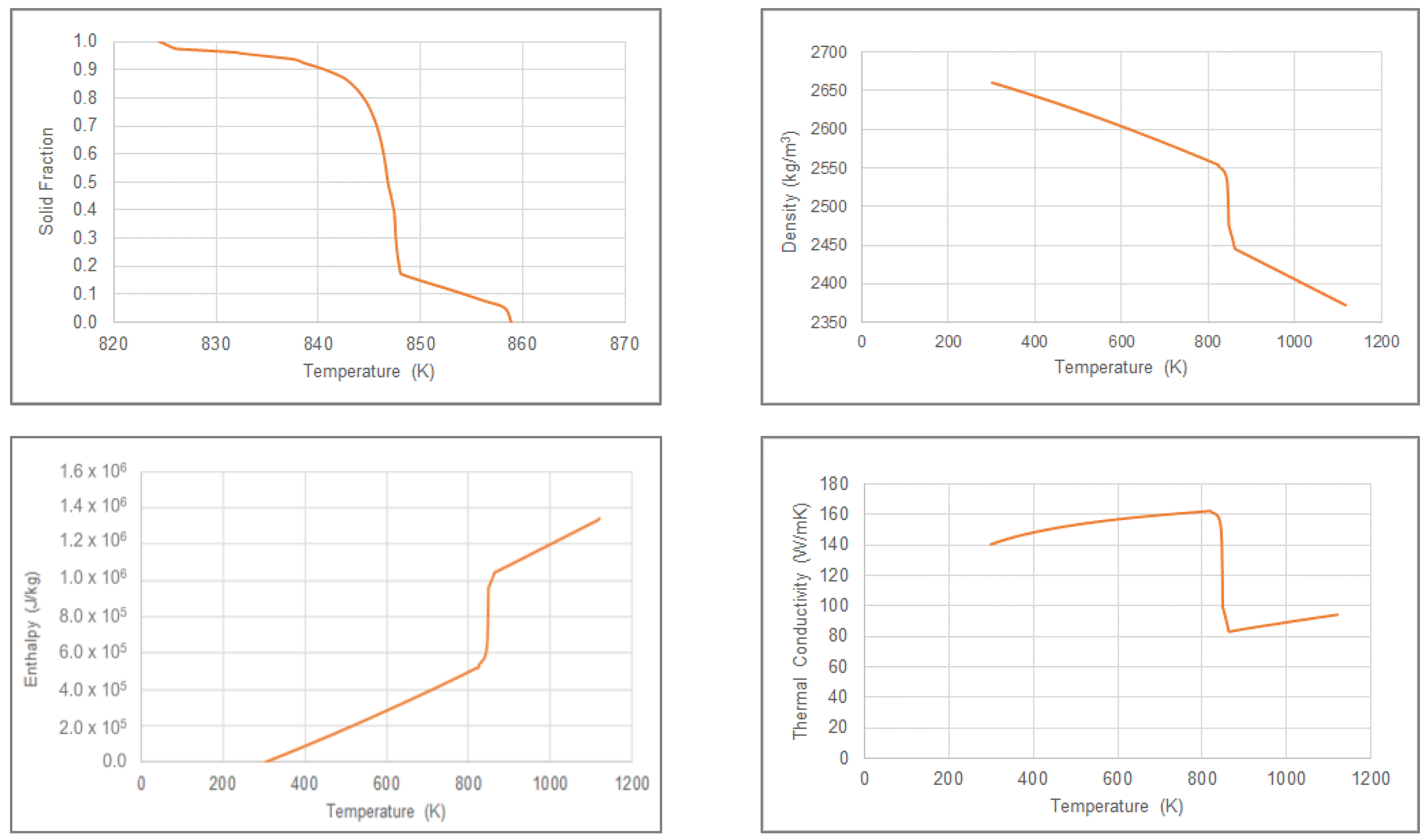


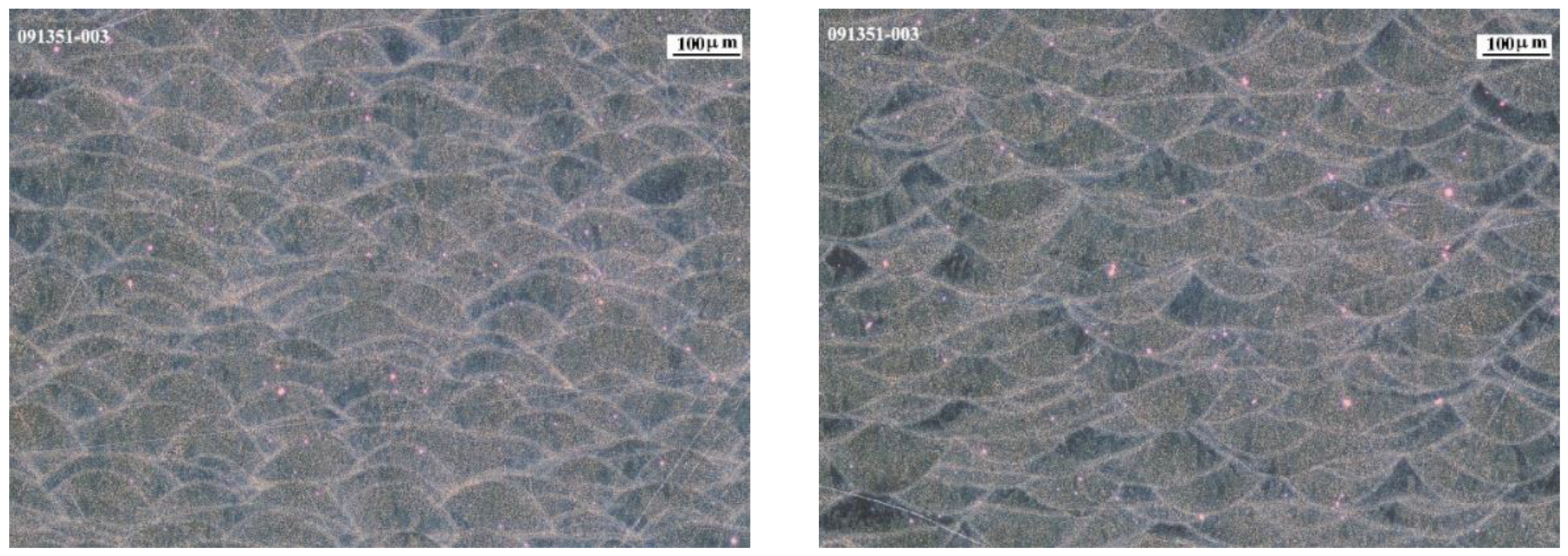
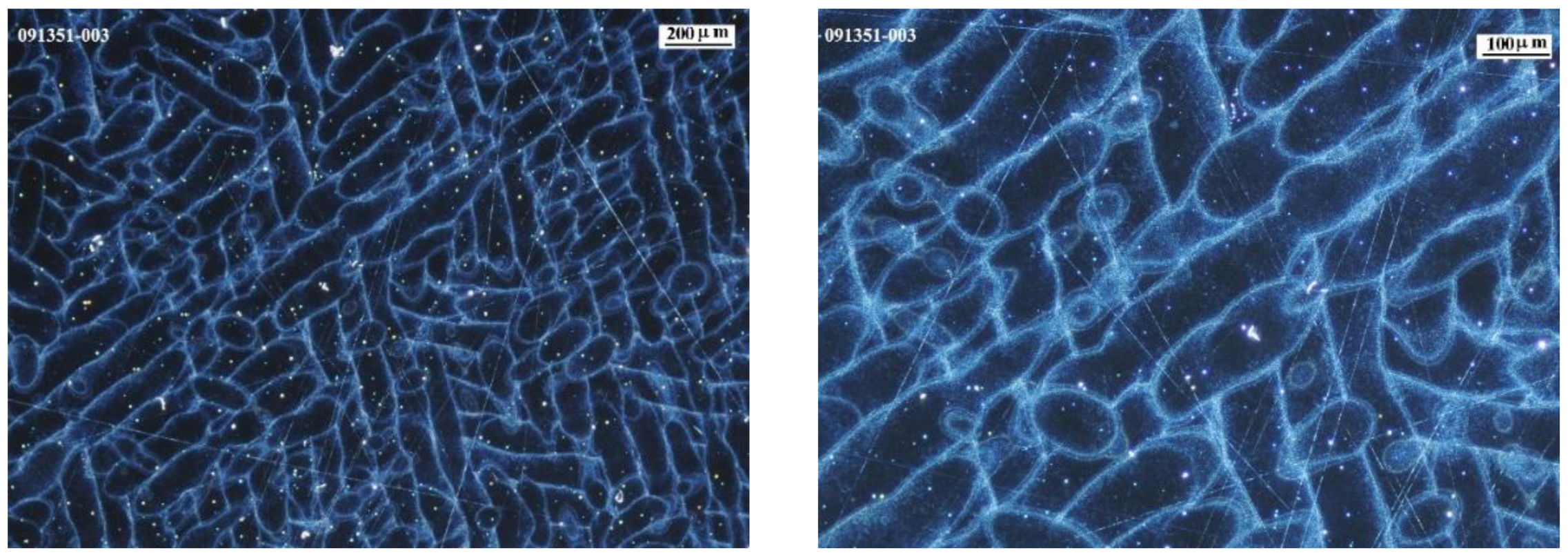
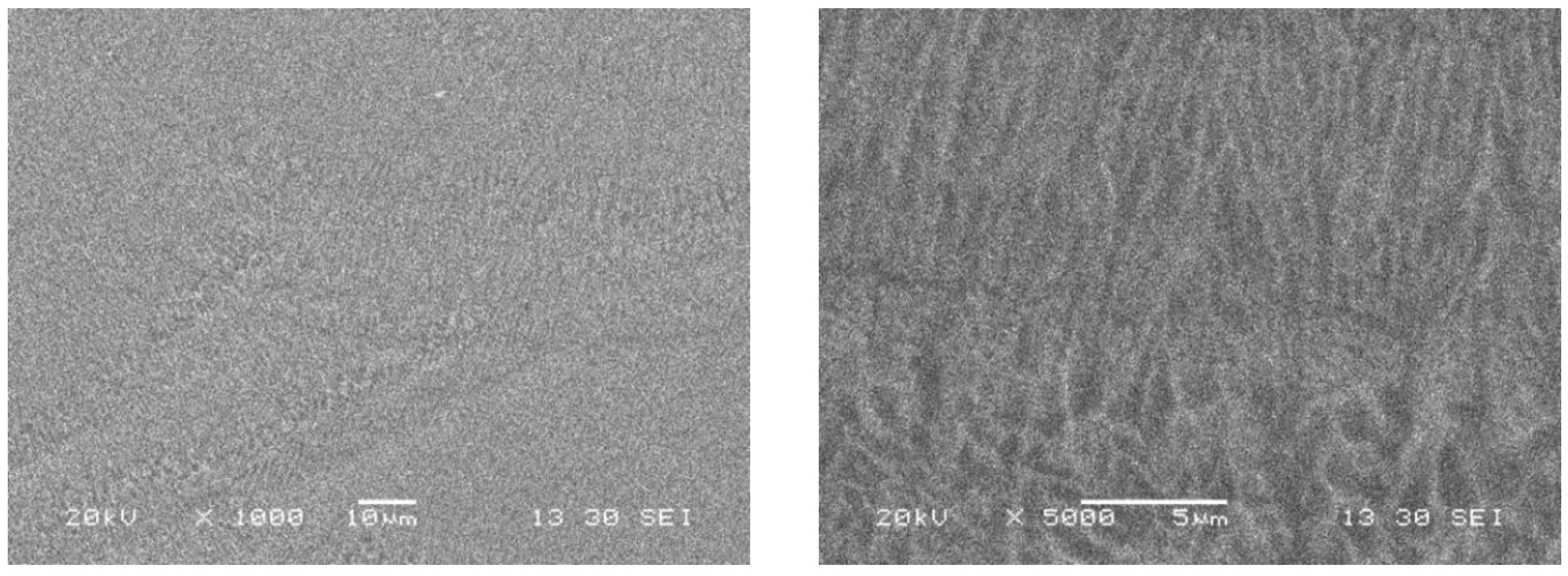
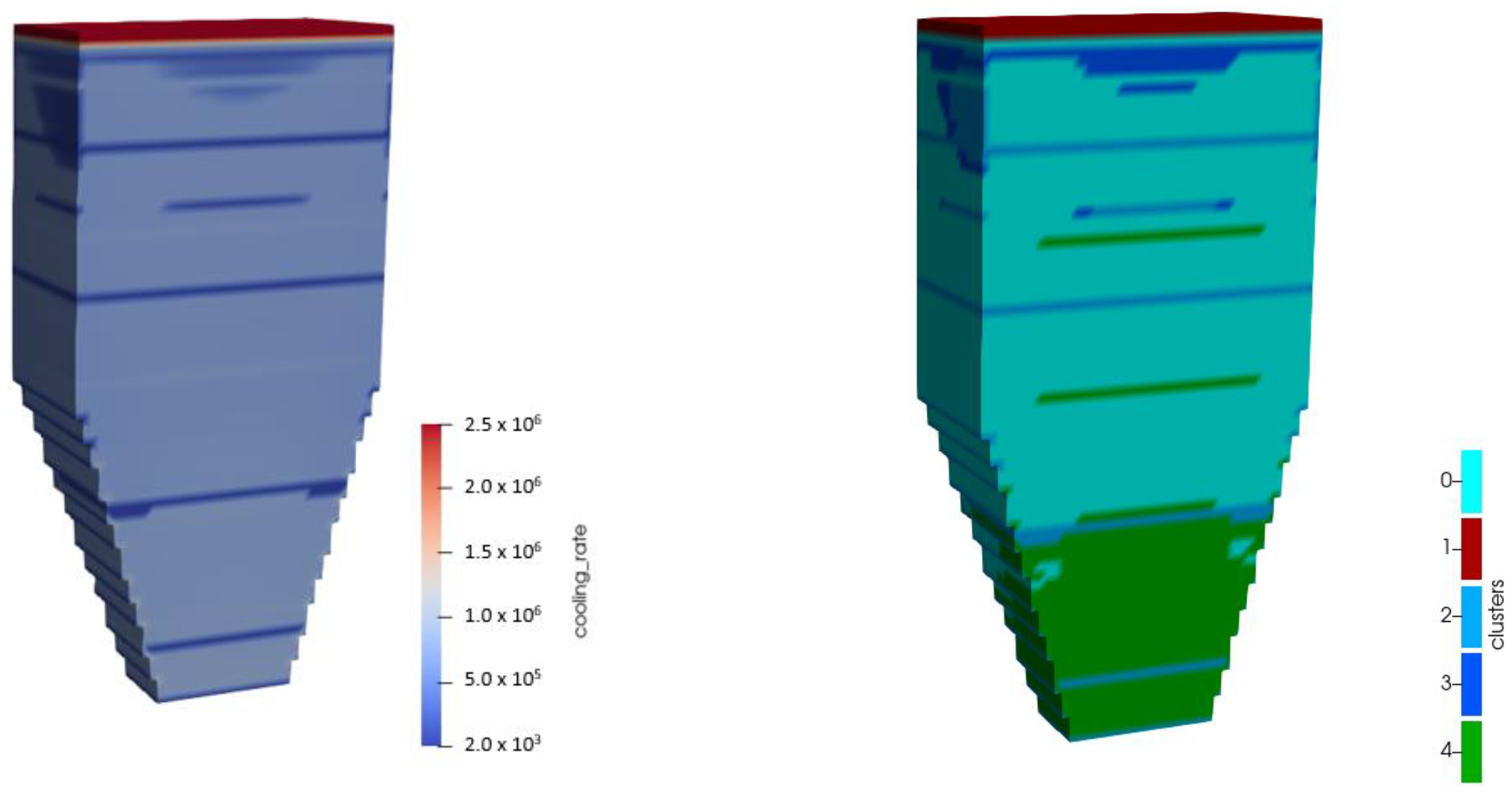
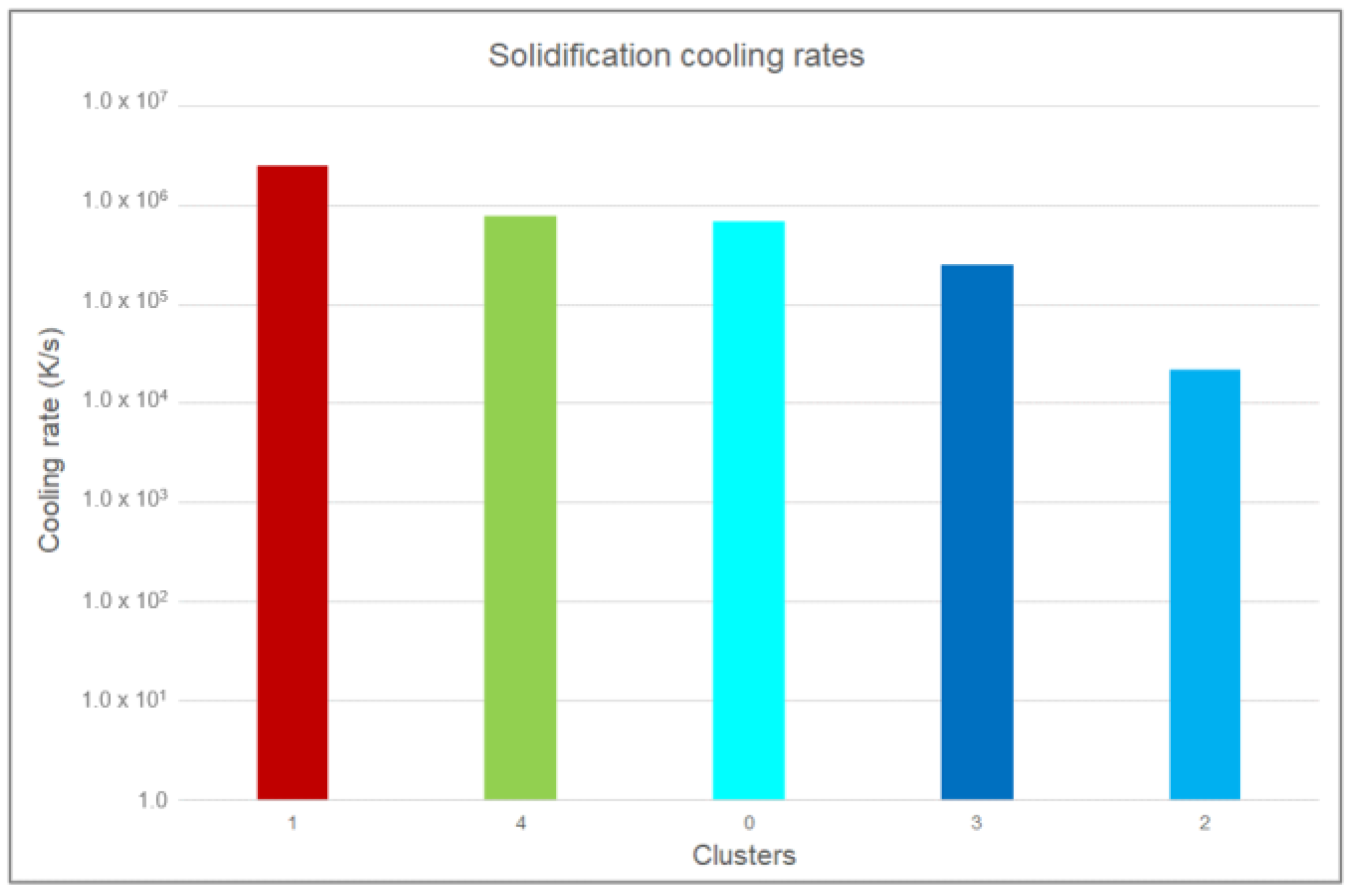
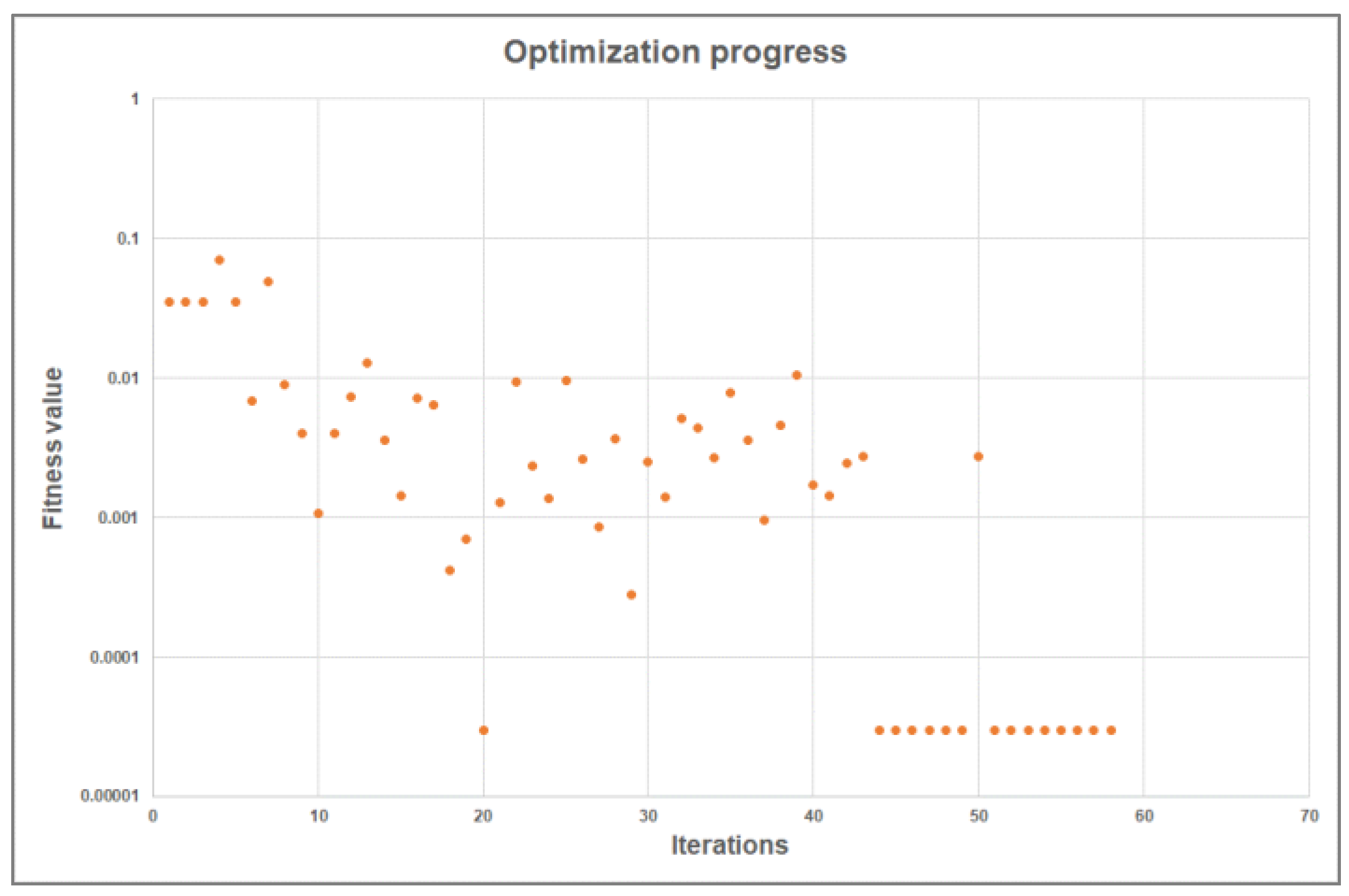

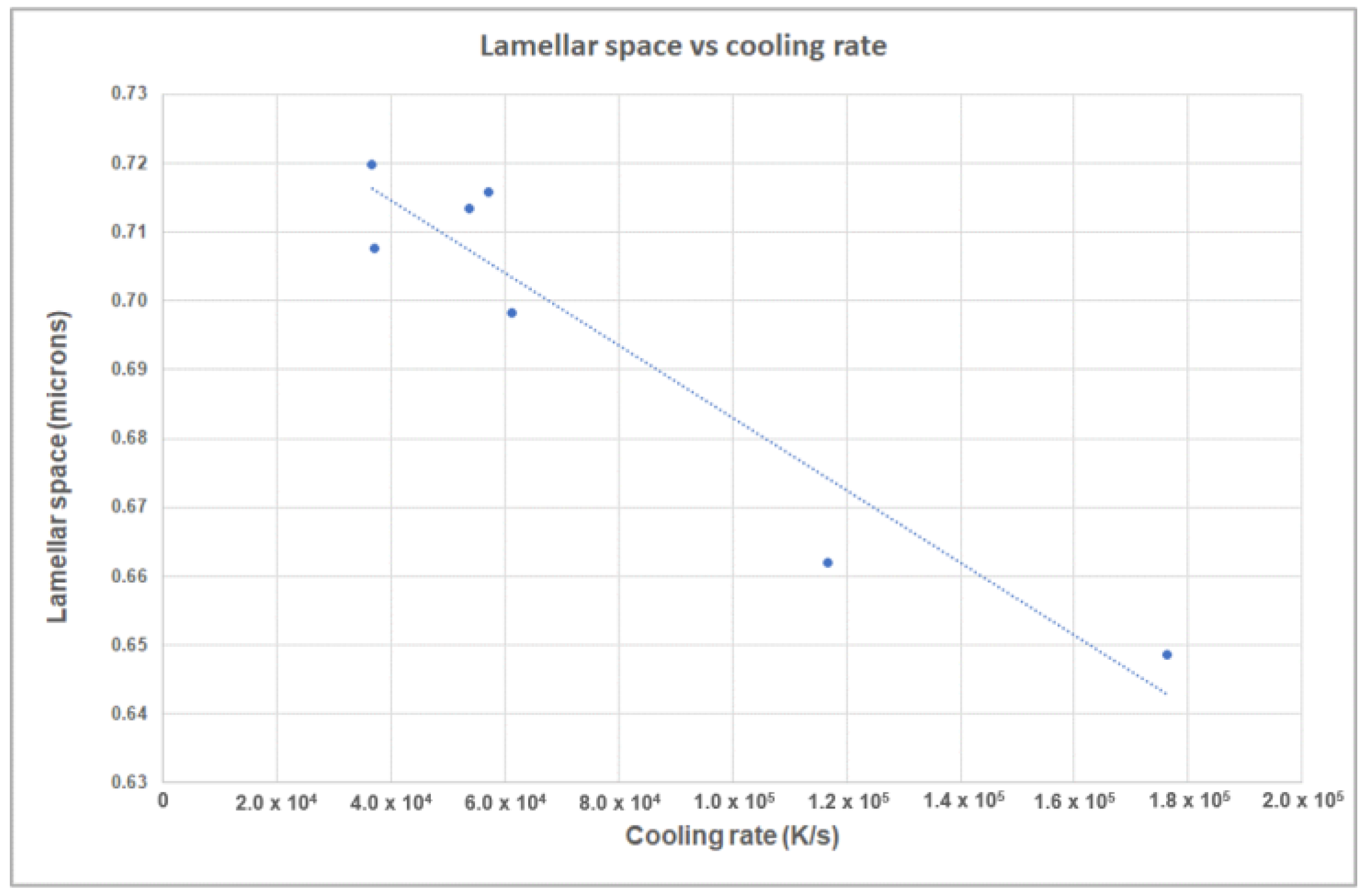
| Al | Si | Fe | Zn | Mg | Cu | Ti | Mn | Ni |
|---|---|---|---|---|---|---|---|---|
| Base | 10.7 | 0.21 | <0.01 | 0.26 | <0.01 | 0.02 | <0.01 | <0.01 |
| Hatch Space (mm) | Laser Diameter (mm) | Velocity (mm/s) | Laser Power (W) | Powder Layer Thickness (mm) |
|---|---|---|---|---|
| 0.15 | 0.071 | 800 | 200 | 0.025 |
| Density (kg/m3) | Specific Heat (J/kgK) | Conductivity (W/mK) | Melting Point (K) | Emissivity |
|---|---|---|---|---|
| 2608.79 | 1005.11 | 151.55 | 846.82 | 0.18 |
| 3.08 × 109 | 7.50 | 25.44 |
Publisher’s Note: MDPI stays neutral with regard to jurisdictional claims in published maps and institutional affiliations. |
© 2022 by the authors. Licensee MDPI, Basel, Switzerland. This article is an open access article distributed under the terms and conditions of the Creative Commons Attribution (CC BY) license (https://creativecommons.org/licenses/by/4.0/).
Share and Cite
Anglada, E.; García, J.C.; Arrue, M.; Cearsolo, X.; Garmendia, I. Lamellar Spacing Modelling for LPBF Aluminum Parts. J. Manuf. Mater. Process. 2022, 6, 164. https://doi.org/10.3390/jmmp6060164
Anglada E, García JC, Arrue M, Cearsolo X, Garmendia I. Lamellar Spacing Modelling for LPBF Aluminum Parts. Journal of Manufacturing and Materials Processing. 2022; 6(6):164. https://doi.org/10.3390/jmmp6060164
Chicago/Turabian StyleAnglada, Eva, José Carlos García, Mario Arrue, Xabier Cearsolo, and Iñaki Garmendia. 2022. "Lamellar Spacing Modelling for LPBF Aluminum Parts" Journal of Manufacturing and Materials Processing 6, no. 6: 164. https://doi.org/10.3390/jmmp6060164








